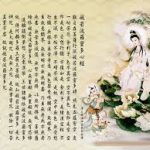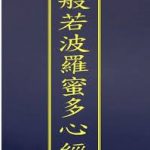《摩訶般若波羅密多心經》經文 中英對照
一、緣起
信堅近日,突然覺得,這世上有許多上根利機之輩,因無機緣,不得明師指點,不知如何入佛法大海。又不知如何看佛經,因此不知佛的富貴。同時又想起當年,看佛經如看天書,認得字,但不知其真義。之後有一位大學同學,送我一本 “六祖壇經的英文版”。信堅瞎貓碰到死老鼠,倒是先看英文,再對照中文,一字一句,慢慢學會如何看佛經。原來佛經是要一字一句的慢慢看,每一字、一句都有無量深廣的義理,都具足 “教理行果、信解行證”。
看過壇經之後,再看其他經典,就容易多了,萬事起頭難。以此為鑑,信堅這幾日,發心以自己五十多年的英文基礎,配合近年讀佛經的解悟,開始著手翻譯重要佛經。昨日草寫了 The True meaning of “Maha Prajñā Paramita” “摩訶般若波羅蜜多”真義解說。今天繼續努力,翻譯《摩訶般若波羅密多心經》。
二、導論 Introduction
佛說法49年,隨機施教,因病與藥。其中,佛說般若22年,總結歸納為《大般若經》,共有六百卷,演說如何以智慧成就法身解脫的法門。《大佛頂首楞嚴經》 是 《大般若經》 的精華。而 《金剛般若波羅密多經》 一卷,便是六百卷大般若經的濃縮精要。至於般若法門精髓的精髓,中心的中心,則是中譯習誦的260字的 《心經》 。因此 《心經》 是《大般若經》的心髓、核心),故曰 《摩訶般若波羅密多心經》。
The Buddha expound (闡述) the scriptures (經典) of buddhism in his life span for 49 years. Among them, the Buddha spent 22 years teaching Prajna, which was summed up in the 600 volumes of “Mahā-Prajñā Pāramitā Sūtra (大般若經)”. The Śūraṅgama Sūtra (大佛頂首楞嚴經) is a summary of its essence, while “The Vajracchedika-prajna-paramita Sutra (金剛般若波羅密多經, The Diamond Sutra) is its concentrated essence. As for the essence of the essence of Prajna Method, the center of the center is the “Heart Sutra”. Its Chinese translation has a total of only 260 words. Therefore, “Heart Sutra” is the heart and core of “Mahā-Prajñā Pāramitā Sūtra “.


「心經」 是佛大弟子舍利弗,問佛如何修持般若法門,如何成佛的方法。佛乃叫觀自在菩薩答覆曰:「三世諸佛以般若波羅密多故,得阿耨多羅三藐三菩提。」故曰: 般若是諸佛之母。
“Heart Sutra” is originated from one of Buddha’s eldest disciples, Sariputra (舍利弗), who asked Buddha how to practice Prajna. Buddha is then called upon Avalokitesvara Bodhisattv (觀自在菩薩) to give the following reply: “The past, present, and future Buddhas attain Buddhahood through the practice of Prajna Paramita. Therefore: it is said that Prajna is the Mother of the Buddhas.
關於此經的中文解說,讀者可參看 “心經般若修証法門” 一文。
其意義與楞嚴經的 “觀世音耳根圓通修証法門” 類似。
此文的主要用意,是將《摩訶般若波羅密多心經》經文,翻成英文。再以中英對照方式陳述。希望精通英文者,能於英文翻譯裡,領會《心經》的真實義。
The main purpose of this article is to translate the verses of “The Maha Prajna Paramita Heart Sutra” into English, and presents in Chinese with English translation. Those who are proficient in English can understand the true meaning of “Heart Sutra” in this English translation.
三、《摩訶般若波羅密多心經》經文,以中英對照陳述。
The Chinese with English Translation Presentation of “The Maha Prajna Paramita Heart Sutra”
觀自在菩薩,行深般若波羅蜜多時 ,照見五蘊皆空 ,度一切苦厄 。
When the Bodhisattva Avalokiteśvara had deeply understood the Supreme Wisdom of Prajñā Pāramitā, he perceived that the five aggregates (skandhas, 五蘊) making up a person were but an illusion, and with this he was relieved from all distress and suffering.
[Five skandhas (五蘊 色受想行識) are: material form (rūpa), sensation (vedanā), discrimination (saṃjñā), thinking (saṃskāra), and consciousness (vijñāna).]
舍利子,色不異空,空不異色,色即是空,空即是色,受想行識,亦復如是。
O Śāriputra, the material form (rūpa) is no different from the void of shapeless emptiness (śūnyatā); the material form is the same as emptiness, and emptiness the same as the material form. The other aggregates —sensation, discrimination, thinking, consciousness — all are the same way. [舍利子Shariputra, one of the eldest Buddha disciple.]
舍利子,是諸法空相,不生不滅,不垢不淨,不增不減。
O Śāriputra, all Dharmas are void in nature. They are neither begun nor ended, neither tainted nor pure, neither increasing nor decreasing.
是故空中無色,無受想行識,無眼耳鼻舌身意,無色聲香味觸法。
And so within the void, there is no material form, no sensation, no discrimination, no thinking, and no consciousness. No eyes, no ears, no nose, no tongue, no physical body, no mind; no sights, sounds, smells, tastes, objects of touch, or Dharmas,
無眼界乃至無意識界,無無明 亦無無明盡。乃至無老死,亦無老死盡。
There are no eighteen boundaries (Astādaśa dhātavah, 十八界:六根、六識、六塵) and no 12 Links of Dependent Origination (十二因緣法).
十二因緣法是 “無明、行、識、名色、六處、觸、受、愛、取、有、生、老死”。
12 Links of Dependent Origination are: “ignorance、mental formations (karma)、consciousness、name and form、six senses、contact、sensation、desire、clinging (attachment)、existence、life、old age, suffering, death”.
無苦集滅道,無智亦無得。
There are even no “Four Noble Truths (四聖諦)” [苦集滅道: suffering, accumulating (of sufferings), cessation (of sufferings), and Way]; no wisdom, nor attainment.
以無所得故,菩提薩埵依般若波羅蜜多故,心無罣礙 無罣礙故,無有恐怖,遠離顛倒夢想。究竟涅盤。
Because there is no attainment, the Bodhisattva through reliance on Prajna Paramita is unimpeded in his mind. Because there is no impediment, he is not afraid, and he leaves distorted dream-thinking far behind. He transcends falsity and attains Ultimately Nirvana!
三世諸佛,依般若波羅蜜多故,得阿耨多羅三藐三菩提。
All Buddhas of the past, present, and future, attain “Anuttara-samyak-sambodhi” (無上症等正覺) through practicing Prajna Paramita. They attain Supreme Wisdom, and are fully awaken to unsurpassable truth, complete and perfect Enlightenment.
故知般若波羅蜜多,是大神咒、大明咒 、無上咒 、無等等咒, 能除一切苦,真實不虛。
Therefore, we know that Prajna Paramita is a Great Spiritual Mantra (zhòu 咒) , a Mantra of great insight, a Supreme Mantra, an Unequalled Mantra. It is able to remove all sufferings, and should be known as truth without deception.
故說般若波羅蜜多咒。即說咒曰: 揭諦‧揭諦‧波羅揭諦‧波羅僧揭諦‧菩提薩婆訶
That is why the Mantra of Prajna Paramita was spoken. Recite it like this Tadyatha: Gate!, Gate! Pāra-gate! Pāra-saṃ-gate! Bodhi. Śvāhā! [Go! Go! Go beyond! Go completely beyond!! To enlightenment. Amen.]

您翻譯得太棒了!!!拜讀者已讀過好些個翻譯版本,真心覺得您的翻譯能很真實的闡釋心經的本意!(因現下正收尋研讀經文,嘗試著翻成西班牙文的版本讓我居住地的朋友們能了解多一些佛經)感謝您!
随喜赞叹!
受想行識 譯為:
sensation, discrimination, thinking, consciousness
有點奇怪,一般 「行」 會譯為「volition」「mental formation」,想譯為「perception」。